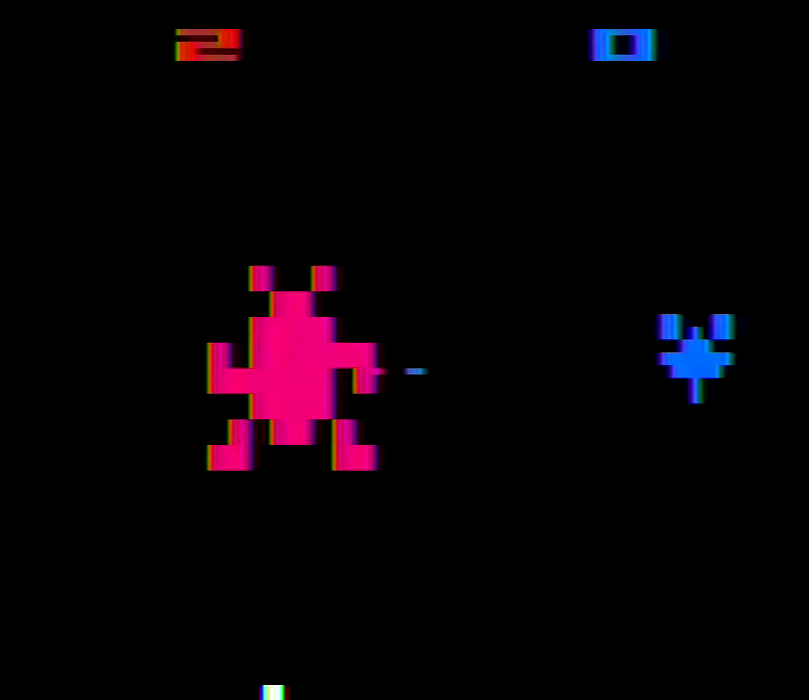
Outer space has been a part of video games almost since their inception. One of the earliest computer games, Spacewar, came about in part because its designers were fans of pulpy science fiction stories such as the Lensman series. Spacewar went on to serve as inspiration for the first commercial arcade game, Computer Space, providing the first glimpse of the setting for public gaming consumption by having players shoot down UFOs within a time limit. Spacewar and the television series Star Trek inspired a text-based fan-made Star Trek computer game in 1971, with players jumping from sector to sector seeking out Klingon ships. But 1977 would prove to be an inflection point for a couple reasons.
First, on February 18, NASA started its test flights of the space shuttle prototype Enterprise. The American space program hadn’t done much since the final Skylab mission in 1973 beyond a largely PR-based linkup with a Soviet Soyuz capsule in 1975. The Enterprise marked the next phase in American manned spaceflight, and while it never achieved the same place in social consciousness as the Apollo moon landings, the shuttles were iconic in their own right .
Secondly and perhaps most notably for video games, on May 25 Star Wars came out in 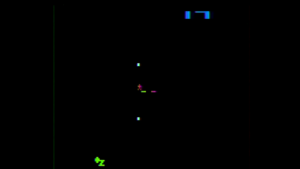 American movie theaters and became a smash hit. This not only revived outer space as a popular setting in science fiction media, it ended up becoming rather influential on video games for years to come – one example of which we’ll be looking at a bit later.
American movie theaters and became a smash hit. This not only revived outer space as a popular setting in science fiction media, it ended up becoming rather influential on video games for years to come – one example of which we’ll be looking at a bit later.
And finally, in July 1977 Atari released its Star Ship 1 arcade game. This was one of the earliest video games to put you in a first-person cockpit perspective (putting aside first-person driving games such as Atari’s Night Driver), and ended up serving as the progenitor of ideas that would appear multiple times over for the next decade, both from Atari and from its competitors. Star Ship 1 was a reasonably popular release at the time, selling around 3,500 units and appearing in the annual top 10 lists for both 1977 and 1978 in coin-op trade periodicals RePlay and Play Meter.
The game itself resembles Computer Space, if played from a different angle. In Star Ship 1, the player’s goal is simply to shoot down enemy ships – which resemble store-brand Federation ships from Star Trek – while dodging their fire. Similar to Computer Space, players are on a timer, and by achieving a high enough score they can get bonus time while in “hyperspace” to keep hunting down enemies. It’s also one of the first games with an easter egg, accessible by holding down the start and phaser buttons while inserting a coin, but only if a particular setting has been activated in the game by the operator.
And launching nearly alongside Star Ship 1 was Star Ship on the Atari VCS, which 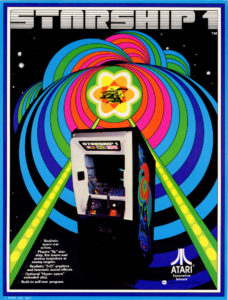 served as a home conversion of the arcade game. Its designer, Bob Whitehead, was hired in January 1977 for the programming department, and Star Ship served as his first game on the platform. Whitehead said that while the developers didn’t get assigned any games at the time, they were strongly encouraged to consider specific Atari properties for their initial VCS titles. And so after playing around with the VCS and getting himself up to speed on its capabilities, he turned to what Atari’s engineers were working on for the arcade space, which included Star Ship 1. Interested in the 3-D perspective of Star Ship 1 – and noting that outer space themes seemed pretty popular for games at the time – Whitehead wanted to see if he could pull off the same effect on the VCS.
served as a home conversion of the arcade game. Its designer, Bob Whitehead, was hired in January 1977 for the programming department, and Star Ship served as his first game on the platform. Whitehead said that while the developers didn’t get assigned any games at the time, they were strongly encouraged to consider specific Atari properties for their initial VCS titles. And so after playing around with the VCS and getting himself up to speed on its capabilities, he turned to what Atari’s engineers were working on for the arcade space, which included Star Ship 1. Interested in the 3-D perspective of Star Ship 1 – and noting that outer space themes seemed pretty popular for games at the time – Whitehead wanted to see if he could pull off the same effect on the VCS.
In hindsight, Whitehead said it was probably not the best choice for his first game project on the platform. Part of this is just how ambitious making a 3-D game on the VCS would be, but at the time he was developing the game, the VCS hardware was still being finalized, and he had to work around those shifting benchmarks. But the challenge and the seeming impossibility of making Star Ship 1 work on the VCS motivated him to keep at it. While he’s not sure he pulled off the conversion to his complete satisfaction, Whitehead felt pretty good about what ended up being his first video game.
Star Ship’s primary game mode, called Space Wars, has essentially the same rules as its arcade counterpart. Players have two minutes and sixteen seconds to destroy UFOs of differing point values by targeting them in the center of the screen and firing missiles at them. At the same time, the player has to avoid colliding with the alien ships or with indestructible groups of asteroids. Different gametypes adjust how fast the objects move and if they come one at a time or in groups of two. Changing the difficulty switch over will weaken your missiles and make alien ships more difficult to hit, making it necessary to hold them in your sights longer to shoot them down.
Space Wars does include a two player mode that puts one player in charge of a space module. The module can’t fight back and is worth two points if destroyed, but it has the option of turning invisible when it nears the targeting reticule of the other player. As such, the module commander’s job is simply to avoid obstacles, which will give the other player points if collided with. After the timer is up, players switch roles, giving the second player a chance to outscore the first. Once the timer is up a second time, the game is finished.
The second game mode on the cart is Space Race, though Whitehead indicated it has no relation to 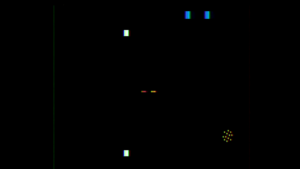 Atari’s 1973 arcade game of the same name. Instead of shooting down alien ships as in the Space Wars variant, the goal is to travel as far as you can within the two minute and 16 second time limit without colliding with asteroids. Each point represents a parsec traveled, and a collision will cause you to lose a parsec for some physics-defying reason. Instead of lasers, pushing the button on the controller will simply speed up the ship. The only gametype differences are how many asteroid clumps appear at once, either one or two. The difficulty switches don’t do anything in this game, nor is there a two player mode – it’s just you, some space rocks, and the open sky.
Atari’s 1973 arcade game of the same name. Instead of shooting down alien ships as in the Space Wars variant, the goal is to travel as far as you can within the two minute and 16 second time limit without colliding with asteroids. Each point represents a parsec traveled, and a collision will cause you to lose a parsec for some physics-defying reason. Instead of lasers, pushing the button on the controller will simply speed up the ship. The only gametype differences are how many asteroid clumps appear at once, either one or two. The difficulty switches don’t do anything in this game, nor is there a two player mode – it’s just you, some space rocks, and the open sky.
The final game mode, Lunar Lander, is essentially a tag game, similar to the one in Indy 500. This game sees the player maneuvering a little Apollo-style Lunar Module around the screen to attempt a landing on the moon, which is drifting around on its own. Once the player approaches the moon, they push the button to fire retrorockets and attempt a landing. A successful landing gains the player a point and sends the moon off on another drifting path. Mistiming the landing sequence will end up destroying the lander and costing a point, as will running into one of the meteors floating across the screen. The difficulty switches adjust how hard it is to actually touch down on the moon, and different gametypes will adjust the speed of the meteors.
Similar to Space Wars, there is a two player option included for Lunar Lander. The 2nd player will take control of the moon and attempt to keep it away from the lunar module; after two minutes and 16 seconds the roles reverse and the second player has to try and land on an uncooperative moon.
Whitehead notes that both Lunar Lander and Space Race were pretty much just variations on the Star Ship 1 theme that worked within the kernel (the VCS equivalent of the game’s engine) he had developed for the main game. Since most of the same elements could be reused without requiring a bunch of new code, they were good fits on the limited space and memory he had to work within.
Star Ship is a fairly middling entry in the initial VCS lineup. None of the game modes are bad, but none of them stand out. Whitehead called the game “clunky” and notes that he’s prouder of the games he’d do later on once he got a better handle on the VCS’s capabilities, but nevertheless it stands as a pretty decent rookie effort. The sound effects in particular were praised in Creative Computing’s July 1978 roundup of VCS software, with David Ahl writing that he found that the eerie noises and the “BLAM” of a successful hit added a lot to the game.
Star Ship does feature the innovative first-person cockpit view in two of the three game modes, which did end up influencing future games on the VCS and elsewhere. Unfortunately for Whitehead’s game, it’s easy to compare it against what came later, and the simplicity of Star Ship pales before the highly influential Star Raiders, apparently released in 1980 for the Atari 8-bit computer line (which itself slowly made its way out the door at the tail-end of 1979). Star Raiders pushed the limits of what people thought the Atari computers – and action games in general – could do, and was critically acclaimed as a major evolution of game design. Developers outside of Atari sought to improve upon the groundwork laid by Star Ship and Star Raiders; for example, in 1982 Activision produced Starmaster, and Starpath released Phaser Patrol for its Supercharger VCS add-on. Both games featured Star Ship’s first person perspective and a variation of Star Raiders “seek out enemy ships on a galaxy map and destroy them” gameplay. The earlier Star Voyager from Imagic by comparison hews far closer to Star Ship’s gameplay, simply requiring players destroy a group of alien vessels before warping to the next level.
Cockpit space shooters did exist on contemporary consoles to the VCS, though they came out well after Star Ship’s debut – unfortunately, there’s no confirmation they were directly influenced by the game. The Channel F saw Galactic Space Wars come out in 1980, after the system and its rights had been purchased by the company Zircon. This game requires players to seek out alien ships using X and Y coordinates and shoot them without taking hits themselves. More interestingly, RCA was working on a cockpit game called Star Wars – yes, deliberately based on the movie but apparently without any kind of official license. The game was in development for its unreleased Studio III game console, but is compatible with the Studio II. RCA licensed out its Studio III technology and games overseas, and so Star Wars did end up seeing release in Europe and Australia. The game simply requires lining up a TIE Fighter within the targeting reticule, at which point the game will automatically shoot it down and score a point. If the TIE goes off screen, it switches to its cockpit and targeting reticule and as the player in an X-Wing trying to avoid getting shot down. This includes a two-player mode where one player is the X-Wing and the other is the TIE Fighter, jockeying for position to avoid getting shot down and to shoot the opponent down. It’s similar to Star Ship’s Space Wars two player mode, but arguably more fun. Magnavox would also publish Cosmic Conflict in 1979 – a very similar first-person target-shooting game that would end up winning an award for best science fiction game in the pages of Video Magazine.
While Star Wars may not have had anything to do with Star Ship, both games were harbingers of the space-themed games that would permeate early programmable game consoles. Whether it’s just a matter of it being easy to create black backgrounds, the influence of Star Wars and science fiction media, or showing off programming tricks, outer space cropped up again and again on the VCS, its competitors, and in arcades. People were really into science fiction games at the time, and it’s a pretty good bet that the success of Star Wars in theaters, Star Trek on televised syndication, and games like Space Invaders in the arcade helped solidify that dominance. It’s a trend that continues even up to the modern homebrew gaming era on the console.
Despite my research, there are a few question marks around Star Ship’s release. For starters, Star Ship seems to have gone through a name change while in development. 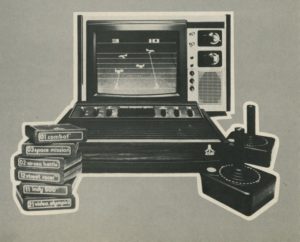 Early press materials and advertisements refer to it as “Space Mission,” and at least one cart featuring just that label exists. Given that Star Ship One came out in August, it makes me wonder if Space Mission had been a development title for the arcade game, but this is something I’ve been unable to say for sure. At the least, Whitehead was unsure if Star Ship 1’s final name was what it was called while being developed internally. Star Ship, under the Space Mission moniker, is also the last game to be highlighted in the earliest VCS newspaper advertisements from August and September; the rest of the VCS 1977 lineup begins being name dropped in Atari’s ads in October along with Star Ship’s final title. It’s possible that those were slightly delayed – Atari’s early advertisements and product reviews indicate that a few of the initial nine games in development were only expected to be out in stores by the end of 1977. In any case, the game was released by Sears as part of its September Tele-Games launch under the name “Outer Space,” and Atari continued to sell Star Ship for a few years before finally discontinuing it around June 1980.
Early press materials and advertisements refer to it as “Space Mission,” and at least one cart featuring just that label exists. Given that Star Ship One came out in August, it makes me wonder if Space Mission had been a development title for the arcade game, but this is something I’ve been unable to say for sure. At the least, Whitehead was unsure if Star Ship 1’s final name was what it was called while being developed internally. Star Ship, under the Space Mission moniker, is also the last game to be highlighted in the earliest VCS newspaper advertisements from August and September; the rest of the VCS 1977 lineup begins being name dropped in Atari’s ads in October along with Star Ship’s final title. It’s possible that those were slightly delayed – Atari’s early advertisements and product reviews indicate that a few of the initial nine games in development were only expected to be out in stores by the end of 1977. In any case, the game was released by Sears as part of its September Tele-Games launch under the name “Outer Space,” and Atari continued to sell Star Ship for a few years before finally discontinuing it around June 1980.
Star Ship is not a particularly fun space mission on its own. But as a starting point for absolute classics like Star Raiders and as the first game on the platform for future Activision founder Bob Whitehead, it’s hard to argue that it’s a decent effort for a starting lineup.
Sources:
Bob Whitehead, interview with the author, September 4 2018
Bob Whitehead, interview with Scott Stilphen, 2005
Chasing the World’s First Easter Egg, Ed Fries, March 22 2017
Atari History Timelines, Michael Current
All in Color for a Quarter, Keith Smith, unpublished manuscript
Release Date Sources:
Star Ship, September 1977: Merchandising, June 1977
Washington Post, September 16 1977
Corvallis Gazette Times, October 29 1977
Galactic Space Wars, August 26 1980: Zircon press release
Star Wars, 1978: Merchandising, July 1978
Weekly Television Digest, June 19 1978
Cosmic Conflict, October 1979: Paris News, October 25 1979
Blytheville Courier, November 23 1979
Star Voyager, February 1982: Videogaming, December 1983
Computer Entertainer, April 1982
Starmaster, June 1982: Activisions, Spring 1982
Star Raiders, March 1980: Weekly Television Digest, November 19 1979
Los Angeles Times, April 5 1980
First Use in Commerce date with US Copyright Office (March 5, 1980)
Phaser Patrol, August 1982: Arcade Express, August 15 1982
Computer Entertainer, September 1982
